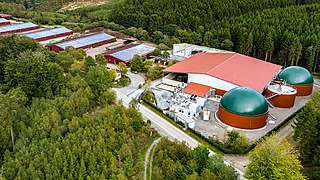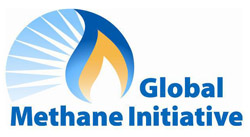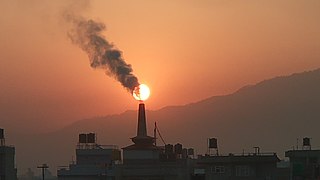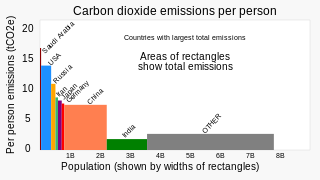
Biogas is a mixture of gases, primarily consisting of methane and carbon dioxide, produced from raw materials such as agricultural waste, manure, municipal waste, plant material, sewage, green waste and food waste. It is a renewable energy source.
Empire State Development (ESD) is the umbrella organization for New York's two principal economic development public-benefit corporations, the New York State Urban Development Corporation (UDC) and the New York Job Development Authority (JDA). The New York State Department of Economic Development (DED) is a department of the New York government that has been operationally merged into ESD.

Anaerobic digestion is a sequence of processes by which microorganisms break down biodegradable material in the absence of oxygen. The process is used for industrial or domestic purposes to manage waste or to produce fuels. Much of the fermentation used industrially to produce food and drink products, as well as home fermentation, uses anaerobic digestion.
The New York Power Authority (NYPA), officially the Power Authority of the State of New York, is a New York State public-benefit corporation. It is the largest state public power utility in the United States. NYPA provides some of the lowest-cost electricity in the nation, operating 16 generating facilities and more than 1,400 circuit-miles of transmission lines. Its main administrative offices are in White Plains.

Long Island Power Authority is a municipal subdivision of the State of New York that owns the electric transmission and electric distribution system serving all of Long Island and a portion of New York City known as the Rockaways. LIPA was originally created under the Long Island Power Act of 1985 to acquire the Long Island Lighting Company (LILCO)'s electric and natural gas infrastructure after the cancellation of the Shoreham Nuclear Power Plant. LIPA acquired LILCO's transmission system in May 1998, while the remainder of LILCO's natural gas-related infrastructure merged with Brooklyn Union Gas to form KeySpan Energy.

The Global Methane Initiative (GMI) is a voluntary, international partnership that brings together national governments, private sector entities, development banks, NGOs and other interested stakeholders in a collaborative effort to reduce methane gas emissions and advance methane recovery and use as a clean energy source. National governments are encouraged to join GMI as Partner Countries, while other non-State organizations may join GMI's extensive Project Network. As a public-private initiative, GMI creates an international platform to build capacity, development methane abatement strategies, engage in technology transfer, and remove political and economic barriers to project development for emissions reduction.
New York state public-benefit corporations and authorities operate like quasi-private corporations, with boards of directors appointed by elected officials, overseeing both publicly operated and privately operated systems. Public-benefit nonprofit corporations share characteristics with government agencies, but they are exempt from many state and local regulations. Of particular importance, they can issue their own debt, allowing them to bypass limits on state debt contained in the New York State Constitution. This allows public authorities to make potentially risky capital and infrastructure investments without directly putting the credit of New York State or its municipalities on the line. As a result, public authorities have become widely used for financing public works, and they are now responsible for more than 90% of the state's debt.

NRG Energy, Inc. is a large American energy company, headquartered in Houston, Texas. It was formerly the wholesale arm of Northern States Power Company (NSP), which became Xcel Energy, but became independent in 2000. NRG Energy is involved in energy generation and retail electricity. Their portfolio includes natural gas generation, coal generation, oil generation, nuclear generation, wind generation, utility scale generation, and distributed solar generation. NRG serves 2.9 million retail customers in Texas, Connecticut, Delaware, Illinois, Maryland, Massachusetts, New Jersey, New York, Pennsylvania, Ohio, and the District of Columbia.

Biodegradable waste includes any organic matter in waste which can be broken down into carbon dioxide, water, methane or simple organic molecules by micro-organisms and other living things by composting, aerobic digestion, anaerobic digestion or similar processes. In waste management, it also includes some inorganic materials which can be decomposed by bacteria. Such materials include gypsum and its products such as plasterboard and other simple organic sulfates which can decompose to yield hydrogen sulphide in anaerobic land-fill conditions.
On April 25, 2006, Executive Order S-06-06, the Bioenergy Action Plan was issued by the then governor of California, Arnold Schwarzenegger, outlining a set of target goals which would establish the increasing use and production of biofuels and biopower for both electricity generation and substitution of natural gas and petroleum within the state of California. The plan asked multiple state agencies to work towards the advancement of biomass programs in California. The order would also help provide statewide environmental protection, mitigation and economic advancement. The plan was passed on July 7, 2006 with progress reports issued in 2007 and 2009.

The United States produced 6.6 billion metric tons of carbon dioxide equivalent greenhouse gas (GHG) emissions in 2019, the second largest in the world after greenhouse gas emissions by China and among the countries with the highest greenhouse gas emissions per person. In 2019 China is estimated to have emitted 27% of world GHG, followed by the United States with 11%, then India with 6.6%. In total the United States has emitted a quarter of world GHG, more than any other country. Annual emissions are over 15 tonnes per person and, amongst the top eight emitters, is the highest country by greenhouse gas emissions per person. Because coal-fired power stations are gradually shutting down, in the 2010s emissions from electricity generation fell to second place behind transportation which is now the largest single source. In 2019, 29% of the GHG emissions of the United States were from transportation, 25% from electricity, 23% from industry, 13% from commercial and residential buildings and 10% from agriculture. These greenhouse gas emissions are contributing to climate change in the United States as well as worldwide.

New York ranked 11th in the United States at the end of 2013 for installed wind power capacity, with 1,722 MW installed. In 2016, wind power provided 2.94% of in state energy production. This increased to 3.66% in 2019.

New York energy law is the statutory, regulatory, and common law of the state of New York concerning the policy, conservation, taxation, and utilities involved in energy. Secondary sources have also influenced the law of energy in the Empire State.
Seneca Meadows, owned by Seneca Meadows, Inc. (SMI) is a landfill in Seneca Falls, New York, near Town of Waterloo, with almost 400 acres (160 ha) of landfill and a 2,600 acres (1,100 ha) facility. It is the largest active landfill in New York State, as well as Seneca County's fourth largest industrial employer. At peak times, the company employs more than 160 full-time workers. In 2005, it accepted more than 6,000 tons of garbage a day from multiple states. The height limit was 280 feet (85 m). Methane gas is sent to a nearby independent facility for producing electricity, some of which Seneca Meadows buys back for its own power needs. Seneca Meadows began producing gas for electricity in 1995, then producing 2.4 Megawatts. Today it produces 18 Megawatts, enough to power 15,000 to 18,000 homes. Seneca Meadows parent company, IESI Corporation, claims that the revenue of the landfill is around $48 million.

Landfill gas utilization is a process of gathering, processing, and treating the methane or another gas emitted from decomposing garbage to produce electricity, heat, fuels, and various chemical compounds. After fossil fuel and agriculture, landfill gas is the third largest human generated source of methane. Compared to CO2, methane is 25 times more effective as a greenhouse gas. It is important not only to control its emission but, where conditions allow, use it to generate energy, thus offsetting the contribution of two major sources of greenhouse gases towards climate change. The number of landfill gas projects, which convert the gas into power, went from 399 in 2005 to 519 in 2009 in the United States, according to the US Environmental Protection Agency. These projects are popular because they control energy costs and reduce greenhouse gas emissions. These projects collect the methane gas and treat it, so it can be used for electricity or upgraded to pipeline-grade gas. These projects power homes, buildings, and vehicles.

The New York Public Service Commission is the public utilities commission of the New York state government that regulates and oversees the electric, gas, water, and telecommunication industries in New York as part of the Department of Public Service. The department's regulations are compiled in title 16 of the New York Codes, Rules and Regulations. The current chairman of the Commission and chief executive of the Department is John B. Rhodes. His term began on June 21, 2017 and runs through February 1, 2021.
Atlantic County Utilities Authority (ACUA) is a public agency in Atlantic County, New Jersey, that is responsible for enhancing quality of life through the protection of waters and lands from pollution by providing responsible waste management services.

The Hudson River-Black River Regulating District (HRBRRD) is a New York state public-benefit corporation that traces its formation to the creation of the Black River Regulating District in 1919, and the Hudson River Regulating District in 1922 in response to the severe historical flooding of the cities of Albany, Green Island, Rensselaer, Troy, and Watervliet by the Sacandaga River and Hudson River and its tributaries. The HRBRRD, formed in 1959 by combining the two entities, collects excess runoff to reduce flooding impacts in the Hudson River and Black River basins, and releases this captured water gradually during periods of low river flow to maintain water quality in each river basin. This system was designed to reduce damage from spring storms and snowmelt, including disease and destruction of life and property, and to improve river navigation and public sanitation. The HRBRRD was also formed with hydroelectric generation in mind. It owns and operates several dams - including the Conklingville Dam which formed the Great Sacandaga Lake - and reservoirs.
Mark C. Walczyk is an American politician and US Army Reserve Engineer Officer from the state of New York. A Republican, Walczyk represents the 116th district of the New York State Assembly, covering Northern Jefferson and St. Lawrence Counties. Walcyzk first won the seat in 2018, when he unseated 10-year incumbent Addie Jenne.












